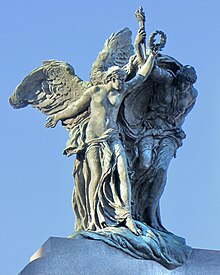Vernon March
| Vernon March | |
|---|---|

Victory and Liberty atop the National War Memorial
|
|
| Born | 1891 Kingston upon Hull, East Riding of Yorkshire, England |
| Died | 11 June 1930 Farnborough, Kent, England |
| Nationality | British |
| Education | No Formal Training |
| Known for | Sculpture |
| Notable work | "Psyche" The Cenotaph, Cape Town Samuel de Champlain Monument Diamond War Memorial National War Memorial of Canada |
English sculptor Vernon March (1891–1930) is renowned for major monuments such as the National War Memorial of Canada in Ottawa, Ontario, the Samuel de Champlain Monument in Orillia, Ontario, and the Cape Town Cenotaph, South Africa. Without the benefit of a formal education in the arts, the prodigy was the youngest exhibitor at The Exhibition of the Royal Academy of Arts.
Vernon March, son of George Henry March and his wife Elizabeth Blenkin, was born in 1891 in Kingston upon Hull, in the East Riding of Yorkshire, England. His father was a seed crusher foreman (oil miller) in Yorkshire. By 1901, the March family had moved to Battersea, London, England, where his father worked as a builder's clerk. Vernon was the youngest of nine children, eight of whom had careers as artists. Three of the March siblings became sculptors, Sydney, Elsie, and Vernon. The other five siblings who chose a career in the arts were Edward, Percival, Frederick, Dudley, and Walter. Vernon's ninth sibling was his sister Eva Blenkin March. Their parents George and Elizabeth both died in 1904.
At the time of the 1911 census, all nine of the March siblings, as yet unmarried, were living together in their 17-roomed home called "Goddendene" in Locksbottom, Farnborough, Kent, England. Two of the siblings eventually married, Eva and Frederick, and produced a total of three children between them. Vernon's sister Eva married Charles Francis Newman in 1916. They had one child, a daughter, Heather. His brother Frederick married a native of Scotland, Agnes Annie Gow, in 1926. They had two children, Elizabeth and Cecil. Vernon served with the Royal Flying Corps after enlisting on 8 March 1916. He was discharged less than one year later, on 24 January 1917, with a rank of Air Mechanic 2nd Class.
The March family established studios at the family home of Goddendene in Locksbottom, Farnborough. In 1911, Vernon exhibited two of his works at The Royal Glasgow Institute of the Fine Arts Annual Exhibition. Between 1907 and 1927, he exhibited seven times at The Exhibition of the Royal Academy of Arts, with a total of twelve works. Vernon had the distinction of being the youngest exhibitor at the Royal Academy of Arts, as he was just sixteen when his sculpture of Psyche was exhibited and purchased on the third day of the event in 1907.
...
Wikipedia
